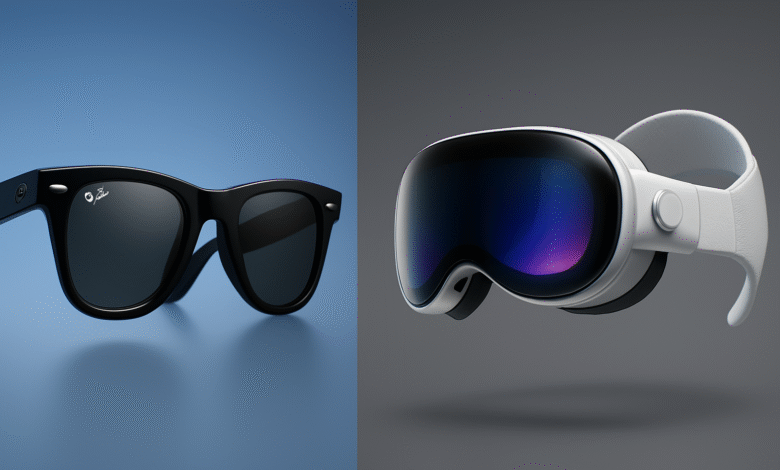
The Smart Glasses Revolution has officially arrived, marking a pivotal moment in wearable technology that’s transforming how we consume digital content and interact with our environment. No longer confined to science fiction, smart eyewear has evolved into sophisticated devices that seamlessly blend style with cutting-edge functionality, creating new possibilities for communication, productivity, and entertainment.
Two industry titans are spearheading this transformation: Meta’s innovative Ray-Ban collaboration and Apple’s highly anticipated Vision Pro Lite. These augmented reality glasses represent fundamentally different approaches to smart eyewear, each targeting distinct user needs while pushing the boundaries of what’s possible in wearable technology.
The modern Smart Glasses Revolution has learned from early missteps like Google Glass, addressing previous concerns about privacy, battery life, and social acceptance. Today’s intelligent eyewear prioritizes user experience, offering sleek designs that people actually want to wear while delivering meaningful functionality that enhances daily life.
Meta’s strategy focuses on social connectivity and content creation, leveraging Ray-Ban’s timeless aesthetic to create smart glasses that look and feel like premium eyewear. Meanwhile, Apple aims to revolutionize personal computing through immersive mixed reality experiences that could redefine how we work, play, and interact with digital information.
Understanding these competing visions is crucial for consumers, businesses, and technology enthusiasts who want to make informed decisions about the future of smart eyewear. This comprehensive analysis examines both platforms’ strengths, limitations, and potential impact on the broader wearable technology landscape.
Meta Ray-Ban Smart Glasses: Redefining Social Connection Through Style
Premium Design That Actually Looks Like Eyewear
Meta’s partnership with Ray-Ban has achieved what many considered impossible: creating smart glasses that people genuinely want to wear. Unlike previous attempts at intelligent eyewear that screamed “prototype,” the Ray-Ban collaboration maintains the iconic styling that has defined cool for generations.
Available in classic Wayfarer, Aviator, and Round frame styles, these smart eyewear devices incorporate advanced technology so seamlessly that most observers can’t distinguish them from traditional Ray-Ban sunglasses. The discrete integration of cameras, speakers, and sensors represents a masterclass in industrial design, addressing the “glasshole” stigma that plagued earlier augmented reality glasses.
The frames feature premium materials including lightweight polycarbonate and metal construction, ensuring comfort during extended wear. Weight distribution has been carefully optimized to prevent the front-heavy feel that often accompanies tech-laden eyewear, making these wearable technology devices suitable for all-day use.
Content Creation Revolution: Hands-Free Photography and Video
The standout feature of Meta Ray-Ban smart glasses lies in their content creation capabilities. Dual 5MP cameras enable users to capture 1080p video and high-quality photos from a natural first-person perspective, eliminating the need to constantly reach for smartphones during memorable moments.
Voice activation allows completely hands-free operation, letting users say “Hey Meta, take a photo” or “Hey Meta, record a video” to capture content instantly. This smart eyewear functionality has proven transformative for content creators, parents documenting family moments, and travelers who want to stay present while preserving memories.
The integration with Meta’s social platforms streamlines content sharing, enabling direct uploads to Facebook and Instagram without additional steps. Advanced privacy features include LED indicators that activate during recording, addressing concerns about unauthorized content capture that have historically challenged intelligent eyewear adoption.
Immersive Audio Without Isolation
Meta’s approach to audio delivery represents a significant breakthrough in smart glasses technology. Open-ear speakers provide surprisingly rich sound quality while maintaining environmental awareness—a crucial safety feature for active users.
The directional audio technology minimizes sound leakage, ensuring private listening experiences without traditional earbuds or headphones. Users can enjoy music, take phone calls, and interact with voice assistants while remaining aware of surrounding sounds, making these wearable technology devices ideal for outdoor activities, commuting, and social situations.
Touch controls on the frame temples enable intuitive interaction, allowing users to adjust volume, skip tracks, or answer calls with simple gestures. Bluetooth 5.0 connectivity ensures stable connections with smartphones and other devices, while the companion app provides extensive customization options for audio preferences and privacy settings.
Apple Vision Pro Lite: Pioneering the Future of Mixed Reality
Next-Generation Display Technology That Changes Everything
Apple’s Vision Pro Lite represents a quantum leap in augmented reality glasses technology, featuring advanced micro-OLED displays that deliver unprecedented visual clarity and color accuracy. Unlike audio-focused smart eyewear, the Vision Pro Lite creates convincing mixed reality experiences where digital objects appear naturally integrated into the physical world.
The device utilizes Apple’s spatial computing technology to render virtual interfaces that feel as tangible as physical objects. This intelligent eyewear approach opens entirely new possibilities for productivity, education, and entertainment, potentially replacing traditional screens for many computing tasks.
High-resolution displays combined with advanced optics ensure text remains crisp and readable, while color reproduction meets Apple’s exacting standards for professional creative work. The smart glasses maintain visual quality across the entire field of view, eliminating the tunnel vision effect that has limited previous augmented reality glasses.
Seamless Ecosystem Integration Across All Apple Devices
Apple’s greatest advantage in the Smart Glasses Revolution stems from their unparalleled ecosystem integration. The Vision Pro Lite promises deep connectivity with iPhones, iPads, Macs, and the extensive App Store ecosystem, creating workflows that span multiple devices seamlessly.
Users could start tasks on their iPhone, continue work on their Mac, and complete projects within their smart eyewear environment without missing a beat. This level of integration positions the Vision Pro Lite as more than just wearable technology—it’s a new computing paradigm that could reshape how we think about personal devices.
The App Store’s vast developer community represents a significant opportunity for the Vision Pro Lite platform. Apple’s track record of fostering innovation suggests rapid development of applications spanning productivity, gaming, education, and specialized professional use cases for augmented reality glasses.
Revolutionary Input Methods: Eyes, Hands, and Voice
The Vision Pro Lite’s advanced sensor array enables natural interaction methods that eliminate the need for external controllers or complex gestures. Eye tracking, hand recognition, and voice commands create an intuitive interface that feels magical rather than technological.
Precise hand tracking allows users to interact with virtual objects using natural gestures, while eye tracking enables selection and navigation through simple gaze patterns. This intelligent eyewear technology makes mixed reality experiences accessible to users regardless of their technical expertise.
The sophisticated sensor suite includes cameras, LiDAR scanners, and motion sensors that enable real-time environment mapping and object recognition. These capabilities position the Vision Pro Lite for professional applications in architecture, design, education, and healthcare where spatial accuracy and environmental awareness are crucial.
Head-to-Head Comparison: Features, Performance, and Value
Visual Capabilities: Audio-First vs. Display-Centric Approaches
The fundamental difference between these smart glasses lies in their approach to information delivery. Meta Ray-Ban smart glasses prioritize audio feedback and smartphone integration, creating an experience that enhances rather than replaces traditional device interaction.
This minimalist approach maximizes battery life and social acceptance while sacrificing the immersive visual experiences that define modern augmented reality glasses. Users receive notifications, directions, and information through high-quality audio while maintaining normal vision and social interaction.
The Apple Vision Pro Lite takes the opposite approach, building everything around rich visual experiences that overlay digital information directly onto the user’s field of view. This smart eyewear strategy enables navigation assistance, real-time translation, immersive gaming, and productivity applications that simply aren’t possible with audio-only devices.
Battery Life and Real-World Usability
Battery performance critically impacts the practical adoption of any wearable technology. Meta Ray-Ban smart glasses excel in this area, offering all-day battery life that supports typical usage patterns including photography, music, and calls without requiring mid-day charging.
The included charging case extends usage time significantly, making these intelligent eyewear devices practical for travel and extended outdoor activities. Users can rely on consistent performance throughout long days without battery anxiety affecting their experience.
The Vision Pro Lite faces greater challenges due to its advanced display and processing requirements. While Apple hasn’t released official specifications, early reports suggest battery life will be measured in hours rather than full days, potentially requiring external battery solutions for extended use.
Pricing Strategy and Market Accessibility
Meta Ray-Ban smart glasses are positioned as premium but accessible entry points into the Smart Glasses Revolution. Pricing competes favorably with high-end traditional sunglasses while adding significant technological capabilities, making smart eyewear accessible to mainstream consumers.
This strategy aims to introduce smart glasses to users who might hesitate to invest in experimental technology, creating a broad foundation for future innovation and feature development.
Apple’s Vision Pro Lite, while more affordable than the full Vision Pro, is expected to command premium pricing that reflects its advanced capabilities and positioning as a next-generation computing platform. The augmented reality glasses will likely target professionals, early adopters, and enthusiasts willing to pay for cutting-edge mixed reality experiences.
Market Impact: How Smart Glasses Are Transforming Industries
Consumer Adoption Trends and Social Acceptance
The success of the Smart Glasses Revolution depends heavily on overcoming the social stigma that has historically challenged wearable camera technology. Meta Ray-Ban smart glasses have made significant progress by maintaining familiar aesthetics and implementing clear privacy indicators.
Consumer response has been increasingly positive, with users appreciating the ability to capture authentic moments without disrupting social interactions. The discrete design allows natural use in various social settings, from family gatherings to professional meetings.
Apple’s approach may face different challenges, as the Vision Pro Lite’s advanced capabilities make it obviously technological. However, Apple’s brand strength and focus on user experience could help normalize more advanced smart eyewear in professional and creative environments.
Professional Applications and Industry Transformation
Beyond consumer use, intelligent eyewear is transforming professional workflows across multiple industries. Architects use augmented reality glasses for on-site visualization, healthcare professionals access patient information hands-free, and field technicians receive real-time guidance during complex procedures.
The Vision Pro Lite’s advanced capabilities position it strongly for professional applications where spatial computing and mixed reality experiences provide tangible business value. Industries including manufacturing, healthcare, education, and design are exploring how smart glasses can improve efficiency and outcomes.
Meta Ray-Ban smart glasses excel in customer-facing roles, content creation, and situations where discrete documentation and communication are valuable. Sales professionals, journalists, and service technicians benefit from hands-free access to information and communication tools.
Future of Smart Glasses: Trends and Technological Evolution
Emerging Technologies Shaping the Next Generation
The Smart Glasses Revolution continues evolving rapidly, with breakthrough technologies promising even more sophisticated wearable technology. Advances in battery chemistry, display miniaturization, artificial intelligence, and 5G connectivity will enable features currently impossible in consumer devices.
Future smart eyewear may include real-time language translation, advanced health monitoring, enhanced navigation with precise indoor positioning, and AI assistants that understand context and provide proactive assistance. These capabilities could position intelligent eyewear as essential daily tools rather than optional accessories.
Machine learning algorithms will improve personalization, adapting augmented reality glasses experiences to individual preferences and usage patterns. This evolution will make smart glasses more valuable and intuitive over time, encouraging long-term adoption and engagement.
Market Predictions and Competitive Landscape
Industry analysts project explosive growth in the smart glasses market, with mainstream adoption expected within the next three to five years. Success factors include continued improvements in battery life, display quality, and social acceptance of wearable technology.
The eventual winner in the Smart Glasses Revolution may not be determined by current products alone, but by each company’s ability to iterate, innovate, and adapt to evolving consumer needs. Both Meta’s partnership strategy and Apple’s ecosystem approach offer viable paths to long-term market leadership.
Competition from Google, Microsoft, Snap, and emerging startups will accelerate innovation and drive down costs, making smart eyewear accessible to broader audiences. This competitive pressure benefits consumers through rapid technological advancement and diverse product options.
Conclusion: Choosing Your Side in the Smart Glasses Revolution
The Smart Glasses Revolution has reached a critical inflection point, with Meta Ray-Ban and Apple Vision Pro Lite representing two compelling but fundamentally different visions for the future of intelligent eyewear. Meta’s approach prioritizes social integration and accessibility, creating smart glasses that enhance existing behaviors without requiring dramatic lifestyle changes. Their partnership with Ray-Ban successfully addresses style and social acceptance concerns while delivering meaningful functionality for content creation and communication.
Apple’s Vision Pro Lite aims higher, attempting to create entirely new computing paradigms through advanced mixed reality experiences and ecosystem integration. This smart eyewear strategy positions Apple to dominate professional applications and users seeking cutting-edge wearable technology capabilities, though at the cost of accessibility and battery life. The choice between these platforms ultimately depends on individual priorities: those seeking discrete enhancement of daily activities will gravitate toward Meta Ray-Ban, while users ready to embrace the future of computing will prefer Apple’s more ambitious approach. Both products represent crucial stepping stones toward a future where augmented reality glasses become as ubiquitous as smartphones, fundamentally changing how we interact with digital information and the world around us.







